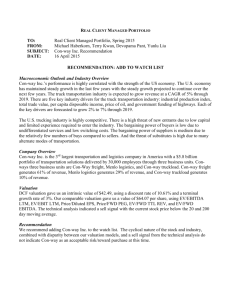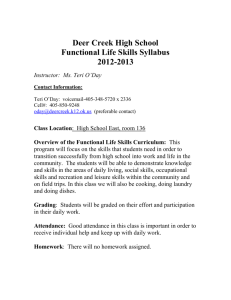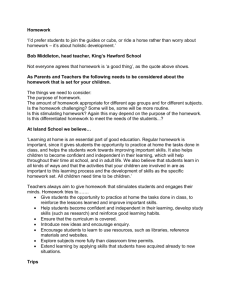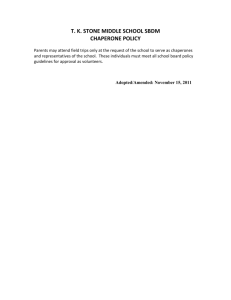Con-way Traffic Analysis – NWDA Feedback
advertisement
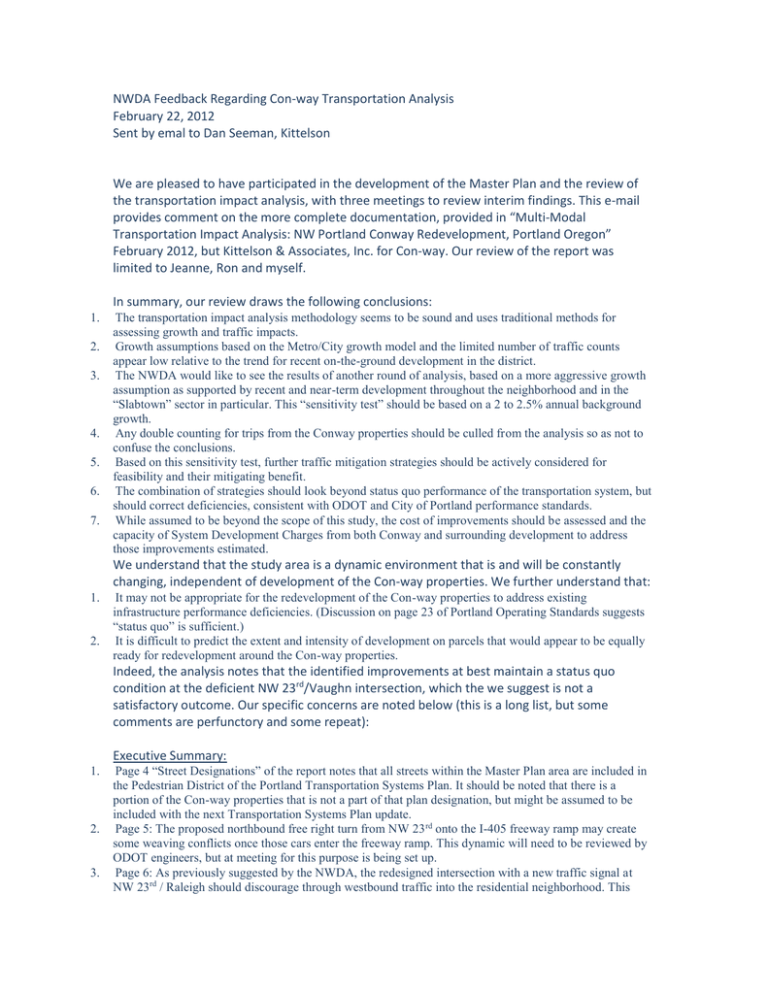
NWDA Feedback Regarding Con-way Transportation Analysis February 22, 2012 Sent by emal to Dan Seeman, Kittelson We are pleased to have participated in the development of the Master Plan and the review of the transportation impact analysis, with three meetings to review interim findings. This e-mail provides comment on the more complete documentation, provided in “Multi-Modal Transportation Impact Analysis: NW Portland Conway Redevelopment, Portland Oregon” February 2012, but Kittelson & Associates, Inc. for Con-way. Our review of the report was limited to Jeanne, Ron and myself. In summary, our review draws the following conclusions: 1. 2. 3. 4. 5. 6. 7. The transportation impact analysis methodology seems to be sound and uses traditional methods for assessing growth and traffic impacts. Growth assumptions based on the Metro/City growth model and the limited number of traffic counts appear low relative to the trend for recent on-the-ground development in the district. The NWDA would like to see the results of another round of analysis, based on a more aggressive growth assumption as supported by recent and near-term development throughout the neighborhood and in the “Slabtown” sector in particular. This “sensitivity test” should be based on a 2 to 2.5% annual background growth. Any double counting for trips from the Conway properties should be culled from the analysis so as not to confuse the conclusions. Based on this sensitivity test, further traffic mitigation strategies should be actively considered for feasibility and their mitigating benefit. The combination of strategies should look beyond status quo performance of the transportation system, but should correct deficiencies, consistent with ODOT and City of Portland performance standards. While assumed to be beyond the scope of this study, the cost of improvements should be assessed and the capacity of System Development Charges from both Conway and surrounding development to address those improvements estimated. We understand that the study area is a dynamic environment that is and will be constantly changing, independent of development of the Con-way properties. We further understand that: 1. 2. It may not be appropriate for the redevelopment of the Con-way properties to address existing infrastructure performance deficiencies. (Discussion on page 23 of Portland Operating Standards suggests “status quo” is sufficient.) It is difficult to predict the extent and intensity of development on parcels that would appear to be equally ready for redevelopment around the Con-way properties. Indeed, the analysis notes that the identified improvements at best maintain a status quo condition at the deficient NW 23rd/Vaughn intersection, which the we suggest is not a satisfactory outcome. Our specific concerns are noted below (this is a long list, but some comments are perfunctory and some repeat): Executive Summary: 1. 2. 3. Page 4 “Street Designations” of the report notes that all streets within the Master Plan area are included in the Pedestrian District of the Portland Transportation Systems Plan. It should be noted that there is a portion of the Con-way properties that is not a part of that plan designation, but might be assumed to be included with the next Transportation Systems Plan update. Page 5: The proposed northbound free right turn from NW 23 rd onto the I-405 freeway ramp may create some weaving conflicts once those cars enter the freeway ramp. This dynamic will need to be reviewed by ODOT engineers, but at meeting for this purpose is being set up. Page 6: As previously suggested by the NWDA, the redesigned intersection with a new traffic signal at NW 23rd / Raleigh should discourage through westbound traffic into the residential neighborhood. This 4. 5. 6. 7. could be accomplished by narrowing the street with curb extensions and installing appropriate signage. The impact of the identified dedicated northbound turning lane on the sidewalk and curb extension dimensions requires careful consideration. (This is stated as a westbound turn lane on page 6, though it would seem “northbound” was intended in this description.) Page 6 refers to an extension of the Line 17 bus route into the Con-way development. That route (proposed for re-designation as Line 77) already bi-sects the Con-way properties along NW 21st and NW Thurman. Any further coverage of the Con-way properties by this route is hard to imagine. Page 6: The bike lanes along NW 18th and 19th already extend the full length to the north, as far as NW Vaughn Street. (This is correctly stated on Page 19). The neighborhood suggested that the Con-way redevelopment include a full service bike station, which is not identified as a multi-modal improvement on page 6. Page 7: the Transportation Demand Management Plan should be coordinated over time with the proposed creation of a neighbor-wide Transportation Parking and Demand Management Association. Introduction: 8. 9. Page 9 “Project Description” assumes that vehicular traffic will access the Con-way properties from NW Vaughn and NW Raleigh. NW Vaughn does not provide direct access. Access actually would come via NW 23rd and NW Thurman Street. This assessment ignores any traffic coming from the south via NW Lovejoy, to the southeast through the Pearl neighborhood or northeast via Naito Parkway. Those impacts, however acceptable, should be noted. Page 9 misstates that vehicular access will not be permitted on the Pettygrove Greenstreet. Traffic on that street will be “calmed” with skinny lanes, but two-way traffic will be retained. Existing Conditions: 10. Page 16, Table 1: On-street parking along NW Vaughn is limited to certain blocks. 11. Page 19: The Line 17 bus does not serve St Helens, Oregon. It travels beyond Montgomery Park, through the industrial district, and then in part along St Helens Road to Sauvie Island and St. Johns. The #15 bus serves NW 23rd Avenue, not the #18 and it splits onto NW Thurman and NW Vaughn with a terminus at Montgomery Park. The #18 serves the Hillside neighborhood, with little direct influence on the Con-way properties. It might be stated that the #77 bus also serves the Pearl and Union Station. 12. It would make sense to include a TriMet service map in the report. 13. The most logical connections from the Con-way properties to the MAX network should be called out. The references to MAX are useless for purposes of this report. 14. Page 23: The “Crash History Review” is based solely on auto-to-auto crashes and ignores crashes involving pedestrians or bicycles. For example, there were 5 reported pedestrian crashes along NW 23 rd between Lovejoy and Thurman between 2006 and 2010. There were 4 bicycle crashes along NW Vaughn in the same period. Multi-Modal Transportation Impact Analysis: 15. The statement on page 27 “No approved but not-yet-built development were identified to occur within the study area that would impact the roadway system beyond the volume forecasts included in the regional traffic volume model” is a questionable statement, as numerous housing projects have recently or will soon be coming out of the ground. These include projects at: the Vaux west of 23 rd at NW 23rd & Savier/Raleigh, Park 19 on the east of the Conway properties, 1984 NW Pettygrove, Savier Flats on former Con-way property at NW 23rd & Raleigh, NW 19th & Johnson, NW 23rd & Lovejoy comprising over 1,000 housing units. 16. The analysis fails to consider the threshold of further development pressures in the northeast quadrant of the neighborhood. Development is creeping into this quadrant from all directions, including the North Pearl. 17. The analysis is based on traffic counts and Metro and City of Portland growth projections, which is a traditional approach in the absence of other intuitive information that uses a more dynamic review of development trends. 18. The traffic counts were taken during a time when employment and household patterns were shifting in response to an economic downturn. 19. The Metro/City of Portland growth model uses aggregate data that become less reliable for this type of subarea analysis. 20. In spite of the traffic counts being corroborated by the model results, the NWDA believes that a 1% growth in background traffic will yield deceptive results. The sensitivity tests are tied to the initial overly conservative conclusions and thus are not helpful in validating the results of this analysis. 21. The report does not define the study area considered for this analysis. It would be helpful to identify the Traffic Analysis Zones (TAZ) and their coverage. We note that TAZ’s 27, 28 and 31 are clearly in the district and TAZs 29 and 30 straddle the Northwest and Northwest Industrial Districts. We would want assurance of consistency in the area used in this analysis. 22. Our meetings have noted that this analysis double counts trips from the Conway development – understood to be the background trip from these properties being left in the analysis as the new Master Planned development is added in. The assertion that this provides a buffer for other conclusions should not be accepted and confuses interpretation of the outcome. The double counting needs to be isolated and removed for clarity and accuracy. 23. Page 29: What is the split of peak trips as a percentage of all trips by each category? AM & PM? Why would there be almost as many office trips OUT in the AM peak as there are IN; and just the opposite for PM Peak? Shouldn’t almost all the trips be OUT and not many in the PM? What percentage of trips is considered AM & PM peak trips? I get that residential trips occur throughout the day, but MOST office trips are concentrated in the peak hours. 24. It seems the report is counting all the residential units as apartments. Is that a correct assumption? It the ITE trip generation rate the same for condominium as for apartments? 25. Internal trips are not identified. These trips will have their own mode split properties in a walkable neighborhood. Why does the PM peak have internal trips by not the AM peak? What are the assumptions behind this? 26. The report uses the same ITE code (820) for shopping centers as for non-grocery retail. Is there a better ITE codes that reflects urban retail for trip generation rates? Proposed Development Plan: 27. The assumptions regarding trip generation and the assignment of trip to the road network appear to be logical and correctly executed. 28. Year 2022 Mitigated Total Traffic Conditions: The NWDA remains cautious that the NW 23 rd/Vaughn eastbound leg of the intersection will operate without significant degradation with the loss of one of the two existing through lanes. The analysis suggests that additional green time will mitigate this change. We would want to know the sensitivity of this condition to even small increases in traffic. 29. There will be some increased tension for the eastbound on-ramp weave between the 1) northbound free right turn, 2) the westbound U-turn lane and 3) the through eastbound traffic. We agree, however, that the proposed changes should be a significant overall improvement to the performance of the intersection. The needs to be examined by ODOT. 30. In spite of the assertion that the proposed traffic signal at Raleigh would not attract traffic into the residential areas west of the intersection, the NWDA nonetheless believes that tight curb extensions across Raleigh on the west side of NW 23rd would be a proactive means of precluding that induced pattern. The question is not one of rational motorist motivation, but more that of 1) perception and 2) the increased activity at this intersection due to the Con-way development itself. 31. Other considerations: Regarding the NW 21st ramp to US 30; the NWDA never intended to suggest facilitating access to US 30 northbound (onto the Fremont Bridge). While the alternative location using the existing southbound on-ramp stub is dismissed as too expensive, it would have been helpful to actually measure it’s potential for relieving PM peak traffic through the NW 23 rd/Thurman and NW 23rd/Vaughn intersections. The last sentence says such a ramp is infeasible, though the analysis only claimed that it is too expensive – not infeasible. It would appear that such a connection is indeed geometrically feasible and may indeed be the most cost-effective means of relieving local PM peak traffic pressure, particularly on the NW 23rd/Thurman intersection. 32. The report does not address the inconsistency in the designation of NW Quimby Street as a bike/pedestrian/emergency street with its designated conversion in the Transportation Systems Plan as a local auto-accessed street. We believe this needs thoughtful consideration given the designation of the adjacent NW Pettygrove as a traffic-calmed green street. Transportation Demand Management Program: 33. Page 55: The analysis draws on various resources to establish mode splits by trip type. It relies on the Nation Household Travel Survey to determine that 15.6% of average annual person trips per household as 34. 35. 36. 37. 38. 39. for the purpose of work commute trips. It is unlikely that trip making patterns in the dense Northwest neighborhood reflect those of the national average, though the bias is hard to predict. More linked trips? Fewer school trips? More non-work trips given the extraordinary number of seniors? Page 56: Similarly, the density and walkability of the neighborhood suggests that more than 87.8% of retail trips will be made by car. This SOV auto percentage is likely to be lower than the National Household Travel Survey might suggest. Page 59: It is highly desirable to add a full-service bike station to the list of TDM strategies. Page 59: The provision of a monthly transit pass subsidy for renters of housing developments might be considered. Page 60: References to the Transportation and Parking Committee should be cross-referenced to the anticipated neighborhood Transportation and Parking Management Association (TPMA) as part of the City’s comprehensive parking plan for Northwest Portland. Page 62: The coverage of capital costs for new shelters and transit information displays needs to be complemented with a means of offsetting operating costs (trash management, information updates, vandalism response, etc.) This would need to be addressed with TriMet. Strategies on Page 62 are very general. What is the ratio of bike spaces to auto spaces? What priorities are given to the location of bike facilities? What arrangements are to be made for the separation of bikes and pedestrians on internal pathways/greenways? Conclusions and Recommendations 40. Page 70: Again, the Line 17 (soon to be 77) route already bisects the Conway district. It is unclear how an “extension” could be achieved to any further benefit of the district. 41. Page 70: Again, bike lanes already are in place for the full length of NW 18 th/19th. They cannot be extended any further! We look forward to reviewing these concerns at the convenience of the Conway Master Plan team. Thanks! Phil Selinger
